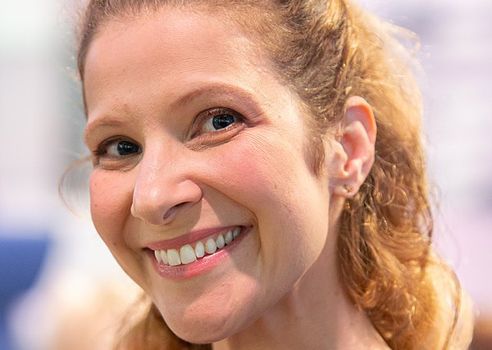Reading time: Less than 2 minutes
I like to share interesting pieces of figurative language I encounter in my reading. I write today about similes and metaphors from Lisa Halliday….
Lisa Halliday (pictured above) became celebrated for her first novel, Asymmetry. It appeared on many top 10 book lists including those of the New York Times, Elle, Kirkus Reviews, Lit Hub and NPR.
I didn’t find the plot quite as brilliant as many of the reviews suggested. The book is divided into three sections, with the first telling the story of a young American editor, and her relationship with a famous and much older writer. The second, apparently unrelated section, is narrated by an Iraqi-American man who is detained by immigration officers in Heathrow. Finally, the relationship between these two tales is revealed in the third section, which has widely been described as a “coda.”
To me, the brilliance of the novel arises from the superb writing style of Lisa Halliday. Her finely tuned eyes and ears display a tremendous gift for richly layered figurative language. Here are my favourite examples:
- His mattress was made of a special orthopedic material that made her feel as though she were slowly sinking into a giant slab of fudge.
- Immediately outside her front door a fifth flight of stairs led up to the roof, or rather to a door bearing warning of an alarm that in two years she’d never heard go off; ignoring it now she ascended through the purple rhomboid of sky and in the relief of a feeble breeze walked across the ceiling to her own apartment to stand at the building’s prow and look down on the street.
- To the right, beyond the ribbon of river black as ink, the shore of New Jersey was illuminated as sparsely as if by campfires in the wild.
- Rustling trees case trembling shadows on the basin, whose layers had chipped away over the years to leave swirls of old grays, greens, and aquamarines, like an antique sea chart.
- The concert was a special guest piano performance by a young Japanese woman who’d already played auditoriums in London, Paris, Vienna, and Milan — although from where they sat now she looked like a child of nine approaching an instrument large enough to be a baby giraffe’s coffin.
- The pianist returned to her bench and stared at the keys reflected there in the high ebony gloss with what seemed a superhuman concentration. Then she flung up her wrists, flared her nostrils, and the Hammerklavier was sprung from its cage: a great rumbling rigorous pounding that was anything but aloof; on the contrary, the woman’s shoulders rocked forward and back, her foot pumped the damper pedal so emphatically that even her heel cleared the floor, and her head jerked wincingly up and to the side as if sparks were flying off the keyboard and threatening to enter her eyes.
- “Look,” Olivia commanded, while her mother vigorously rubbed sunblock into her arms; flanked by four chocolate-filled molars, the loose tooth teetered steeply back and forth under her finger like a drunk.
- A Bavarian grad of the Paris Conservatoire, he was a devoutly trim man who took his early-morning constitutionals in paisley cravats that on the pavements of Bay Ridge looked as exotic as if he’d wound in Indian cobra around his neck.
An earlier version of this post first appeared on my blog on Jan. 10/19.
[Photo credit: Cropped version of image from: Martin Kraft. License: CC BY-SA 3.0 via Wikimedia Commons]


